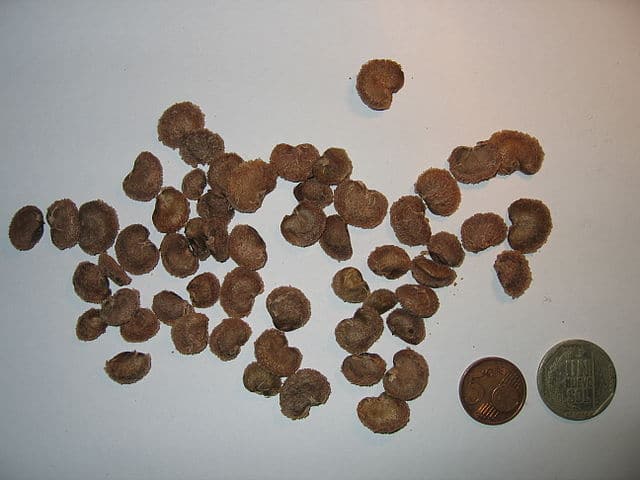Camu Camu:
What is it?, History, Cultivation, Nutritional Value, Uses, Recipes, and More...
Camu Camu is a native Peruvian species that grows along riverbanks and in floodable areas of the Amazon rainforest. It is one of the richest sources of natural vitamin C, providing up to 60 times more vitamin C than an orange. It is also a powerful antioxidant and contains bioactive compounds that may help delay or prevent various cardiovascular diseases and cancer. Its benefits include supporting healthy eyes and skin, as well as maintaining healthy white blood cell levels.
Índice
What is Camu Camu?
Camu Camu is a shrub native to the Peruvian Amazon, which grows wild along riverbanks and in floodable areas of the Amazon rainforest. It is mainly found along the Ucayali and Amazon rivers and their tributaries, in the region between the towns of Pucallpa on the Ucayali River and Pebas on the Amazon River. It also grows in some regions of Bolivia, Brazil, Colombia, Ecuador, and Venezuela.
Morphologically, it is a dicotyledonous shrub that reaches a height of 3 to 8 meters depending on the environmental conditions. It branches out from the base, creating several secondary stems that branch out in an open vase shape. The stem and branches are cylindrical, smooth, light brown or reddish in color, and naturally shed their bark.
The leaves of Camu Camu are lanceolate to elliptical, with individual leaves measuring between 3-20 centimeters in length and 1-2 centimeters in width.
The flowers, on the other hand, are small, white, waxy, and emit a sweet fragrance. Its fruit has a smooth and shiny surface, is oval-shaped, and can be red, green, or a combination of both depending on its degree of ripeness. It measures between 2 to 4 centimeters and is characterized by its acidic taste and high content of ascorbic acid (vitamin C) and different bioactive compounds that could be used to delay or prevent various cardiovascular diseases and even cancer.
History of Camu Camu
It is known that Camu Camu was first used by indigenous peoples of the Amazon region as a source of food and herbal medicine for hundreds of years before the world became aware of it. When its medicinal and nutritional potential was investigated by the Peruvian government in the 1950s, the popularity of this tropical plant began to grow exponentially, mainly due to its high content of vitamin C and antioxidants. Its cultivation has increased due to the demand from pharmaceutical companies and the juice and beverage industry, initially concentrated in the Netherlands and Japan. Currently, it is a crop with great socio-economic potential and is imported by countries such as Japan, France, and the United States.
Historically, there is evidence that Camu Camu was considered a natural source of vitamin C by Ferreyra in 1959 in his monthly report at the La Molina Agricultural Experimental Station. There is also evidence that Antúnez de Mayolo (1981) in his work “La Nutrición del Antiguo Perú” mentions this fruit in literature as follows:
“[…] The main wild fruits were camu camu (Myrciaria paraensis sp.).”
In 1986, the FAO commented on its natural distribution, indicating that its upper limit is at an altitude of 200-300 meters above sea level. Later, Engineer Mario Pinedo from IIAP became a specialist in this crop, having collected information that exceeds 400 references. In 2007, this engineer conducted research studying over a hundred residents of the Amazonian northeast and discovered that they use camu camu to treat an average of 36 diseases, with the predominant use for arthritis (33%), colds (17%), diabetes mellitus (1%), cholesterol (7%), bronchitis (4%), vitamin C deficiency (4%), inflammation (2%), and flu. He also determined that it is traditionally used in Loreto to treat the following diseases: asthma, atherosclerosis, cataracts, depression, flu, gingivitis, glaucoma, hepatitis, infertility, migraines, osteoporosis, and Parkinson’s. In addition, it is used as an analgesic, antiviral, and antioxidant.

Common Name of Camu Camu
| Perú | Camu camu, Camocamo |
| Brasil | Cacari/ araça de agua, azedinha, miraúba y muraúba |
| Colombia | Guayabo |
| Venezuela | Guayabito, limoncillo |
| EE. UU | Camu plus |
Scientific Name of Camu Camu
Myrciaria Dubia
Taxonomy of Camu Camu
| Reino | Plantae |
| División | Magnoliophyta |
| Clase | Magnoliopsida |
| Subclase | Rosidae |
| Orden | Myrtales |
| Familia | Myrtaceae |
| Subfamilia | Myrtoideae |
| Tribu | Myrteae |
| Género | Myrciaria |
| Especie | Myrciaria dubia |
Synonyms of Camu Camu
- Eugenia divaricata Benth.
- Eugenia grandiglandulosa Kiaersk.
- Marlierea macedoi D.Legrand
- Myrciaria caurensis Steyerm.
- Myrciaria divaricata (Benth.) O.Berg
- Myrciaria lanceolata O.Berg
- Myrciaria lanceolata var. angustifolia O.Berg
- Myrciaria lanceolata var. glomerata O.Berg
- Myrciaria lanceolata var. laxa O.Berg
- Myrciaria obscura O.Berg
- Myrciaria paraensis O.Berg
- Myrciaria phillyraeoides O.Berg
- Myrciaria riedeliana O.Berg
- Myrciaria spruceana O.Berg
- Myrtus phillyraeoides (O.Berg) Willd. ex O.Berg
- Psidium dubium Kunth
Etymology of Camu Camu
According to popular knowledge, “camu” is the sound produced by fish when they consume the fallen camu fruits in the water. It comes from the Tupi language (an indigenous language of South America).
Cultivation, Distribution, and Habitat of Camu Camu
- Habitat
- Distribution
- Cultivation
Habitat of Camu Camu
The natural habitat of camu camu is the floodable alluvial forest, being a riparian species. It is found especially along the banks of the Solimoes (Amazonas), Negro, Trombetas, Xingu, Tocantines, Madeira, Tapajos, Acre, Yavari, Macangana, and Urupé rivers in Brazil; Amazonas, Ucayali, Marañón, Napo, Tigre, Curaray, Yavarí, and Tahuayo rivers in Peru; Putumayo and Inírida rivers in Colombia; as well as in the upper Orinoco basin in Venezuela. Its highest concentration and diversity are found in the Peruvian Amazon (Peters and Vásquez, 1986; Chávez, 1993; SEBRAE, 1995).
Distribution of Camu Camu
Camu camu is found only in territories with more than 1500 mm of annual precipitation at temperatures above 20ºC (requires full exposure to sunlight). It seems that an altitude of over 200-300 meters above sea level is the upper limit for the species' distribution.
Cultivation of Camu Camu
It is tolerant to flooding and can be fully submerged in water for four to five months. It is propagated by seeds, which are found in numbers of one to three in each fruit and have a viability of over 90% when freshly separated from the fruit. Propagation by grafting selected clones is preferred. Planting is done with a spacing of 4 meters between rows and 3 meters between plants, resulting in 833 plants/ha. Transplanting is done with bare roots and harvesting usually takes place between the months of December and March.
Geographical Distribution of Camu Camu

Loreto, Amazonas, Ucayali
Seasonal Availability of Camu Camu
- February, March, April, May, June, October, November
Varieties of Camu Camu
Recently, the first improved variety of camu camu has been developed, the INIA 395 VITAHUAYO, developed by the Ministry of Agriculture and Irrigation (MIDAGRI) through the National Institute of Agricultural Innovation (INIA). It offers a production of 2,660 fruits per plant, equivalent to 38 kilograms, and over 42 tons per hectare. This will increase the producer’s economy by 40%.
Nutritional Value of Camu Camu
The fruits of camu camu contain an incredible concentration of vitamin C, their greatest nutritional contribution. Until recently, it was believed to have at least 16 times more vitamin C than orange pulp, but during a recent exploration of the Amazon, specimens were discovered that have between 3000 to 6000 mg of ascorbic acid per 100 g of pulp, which means between 57 and 114 times more concentration than an orange. Vitamin C contributes to the formation of bones, teeth, skin, cartilage, ligaments, and collagen, a protein involved in the development of tendons and blood vessels.
This Amazonian fruit also provides various amino acids such as serine, valine, and leucine, as well as other nutrients such as sodium, potassium, calcium, zinc, magnesium, manganese, and copper. It is an important source of nutritional antioxidants, β-carotene, and phenolic compounds such as ellagitannins, ellagic acid, quercetin glucosides, syringic acid, and myricetin.
Additionally, it is a powerful anti-inflammatory, antimicrobial, and it is also a great ally against cardiovascular diseases and for people suffering from obesity. Research has shown its positive effect in the treatment of early stages of diabetes, cancer prevention, as well as offering other benefits such as improving migraines, headaches, diabetes, arthritis, severe flu, and colds (Nascimento et al., 2013).
It has been demonstrated that this berry decreases blood lipid levels and, therefore, counteracts diseases such as atherosclerosis, heart disease, stroke, and hypertension, as well as dyslipidemia, which manifests with extraordinary amounts of cholesterol and triglycerides in the blood (Schwertzi et al., 2012).
It also has the ability to protect the mucous membrane of the gastrointestinal tract from the action of the acidic environment, digestive enzymes, and cells of the body (Rafael et al., 2010). Finally, it has been shown that camu camu, in combination with black maca (Lepidium meyenii), significantly influences the increase in sperm production (Gonzales et al., 2013).
Health Benefits of Camu Camu
The main benefit of camu camu lies in its amount of vitamin C (ascorbic acid) and antioxidants.
Contraindications or Side Effects
So far, no side effects or contraindications associated with camu camu fruit are known. However, due to the acidic nature of the plant, it is recommended to consume it in moderation because excessive consumption could cause stomach acidity or indigestion.
| 10 Porciones por Kilogramo | |
| Tamaño de porción | 100g |
| Cantidad por porción Calorías |
24 |
| Cantidad por 100g | |
| Energía | 100 kJ |
| Grasa Total | 0.1 g |
| Sodio | ● |
| Carbohidratos totales | 5.9 g |
| Carbohidratos disponibles | ● |
| Fibra Dietaria | ● |
| Proteínas | 0.5 g |
| Calcio | 28 mg |
| Fósforo | 15 mg |
| Zinc | ● |
| Hierro | 0.50 mg |
| Potasio | ● |
| Agua | 93.3 g |
| Cenizas | 0.2 g |
| Vitamina A | 0 μg |
| Tiamina (B1) | 0.01 mg |
| Riboflavina (B2) | 0.04 mg |
| Niacina (B3) | 0.61 mg |
| Vitamina C | 2,780.00 mg |
| Acido Fólico (B9) | ● |
| β-Caroteno | ● |
| Fuente: Tablas peruanas de composición de alimentos – Centro Nacional de Alimentación y Nutrición – Ministerio de Salud – Perú | |
Derived Products and Consumption Forms of Camu Camu
Uses of Camu Camu
The uses of camu camu are mainly culinary, medicinal, and recently, also industrial.
- Culinary
- Medicinal
- Industrial
Culinary use of Camu Camu
Camu camu is consumed as powdered camu camu (as a vitamin C supplement), nectar, soft drink, ice cream, and yogurt. It is also used in desserts such as ice cream, jams, and pies.
Among its multiple presentations are flour, pulp, capsules, nectar, as liqueurs, in confectionery, among others.
Medicinal use of Camu Camu
Currently, camu camu is used as an antiviral, laxative, anti-inflammatory, and for influenza A(H1N1). Capsules are produced that can be taken in fixed daily doses and are easy to ingest to prevent colds, treat anemia, and protect eye health.
It is also used as herbal remedies, such as camu camu syrup and extract, although they are not the best ways to consume it as the essential nutrients of the herb degrade when exposed to heat.
Traditionally, native medicine has recommended it for the following reasons:
Strengthens and maintains the immune system.
Promotes energy and vitality in individuals with chronic immune dysfunction.
Prevents cancer and heart diseases.
Revitalizes the nervous system.
Detoxifies the body.
Prevents stress.
Promotes good heart and circulatory health.
Promotes nutrient absorption (including iron) in the digestive system.
Essential for sperm production.
Helps fight diabetes.
Accelerates wound healing.
Industrial use of Camu Camu
Camu camu is used in aquaculture as it has been shown that consumption of this fruit extract contributes to the growth of fish and improves their immune response (species: Nile tilapia) when orally administered in combination with feed at a dose of 500 mg/kg of feed (Yunis-Aguinaga et al., 2016).
This berry is also used in the cosmetic industry as a natural beauty product because it has the ability to increase collagen production, which helps repair split ends of the hair while regenerating its shine and strength. It is commonly used as a homemade hair tonic and has already entered the market as a commercial shampoo.
Furthermore, recent studies have determined that the peel of mature camu camu fruit contains a good concentration of the pigment anthocyanin, which is suitable for dye manufacturing.



